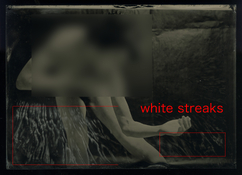The first scanned image is a 5x7-inch ambrotype. Occasionally, I encounter white streaks like those. I can remove some of them during washing after fixing, but sometimes they remain visible.
Could this be caused by unexposed silver that gets developed and remains on the plate?
(My development time is between 15 to 20 seconds).
Another possibility is that my silver bath pH might be too high (mine is ph4-5). However, before attempting to lower it, I’d appreciate any insights from others.
Could this issue be improved by slightly increasing the acidity of the developer?
Additionally, I have a question about the crepe lines (attached). I know that excessive water in the collodion or failure to rock the plate properly after pouring can lead to creating crepe lines, so I take care to avoid these. However, I still sometimes get them, and I haven't been able to fully understand their causes or patterns.
Do crepe lines tend to appear more easily when the room humidity is low or the room temperature is high?
What are the possible causes of crepe lines? I typically use fresh collodion, so its viscosity is not particularly high.
Someone advised that if the viscosity of collodion increases, adding ether would help. However, I only have a mixture of ether and grain alcohol, so I want to know if it’s okay to add this mixture. I’m concerned because the alcohol in the mixture contains some water.
Any advice would be greatly appreciated!
Could this be caused by unexposed silver that gets developed and remains on the plate?
(My development time is between 15 to 20 seconds).
Another possibility is that my silver bath pH might be too high (mine is ph4-5). However, before attempting to lower it, I’d appreciate any insights from others.
Could this issue be improved by slightly increasing the acidity of the developer?
Additionally, I have a question about the crepe lines (attached). I know that excessive water in the collodion or failure to rock the plate properly after pouring can lead to creating crepe lines, so I take care to avoid these. However, I still sometimes get them, and I haven't been able to fully understand their causes or patterns.
Do crepe lines tend to appear more easily when the room humidity is low or the room temperature is high?
What are the possible causes of crepe lines? I typically use fresh collodion, so its viscosity is not particularly high.
Someone advised that if the viscosity of collodion increases, adding ether would help. However, I only have a mixture of ether and grain alcohol, so I want to know if it’s okay to add this mixture. I’m concerned because the alcohol in the mixture contains some water.
Any advice would be greatly appreciated!




 After pouring the collodion for the crepe lines, I'll ensure I rock it more.
After pouring the collodion for the crepe lines, I'll ensure I rock it more.